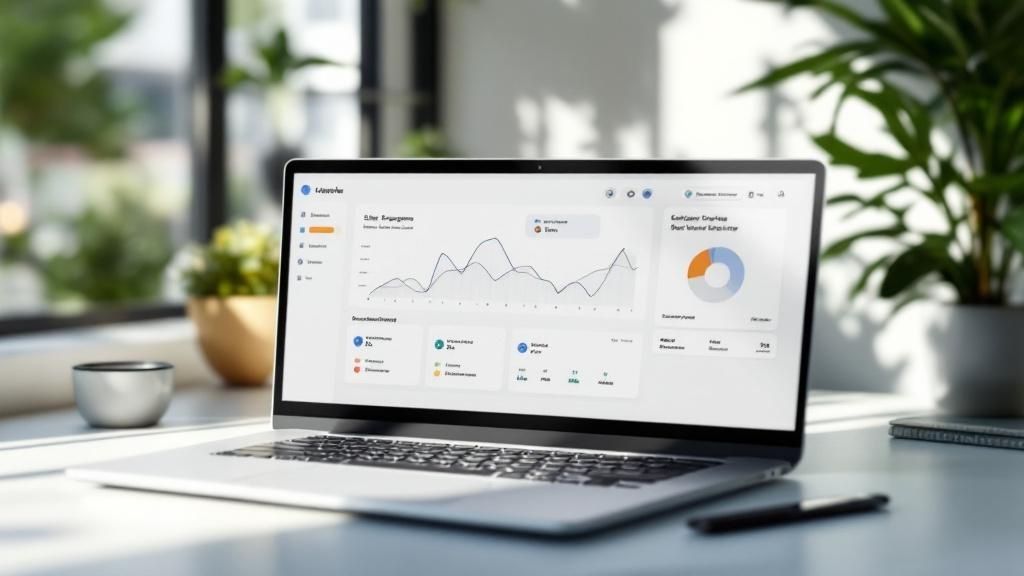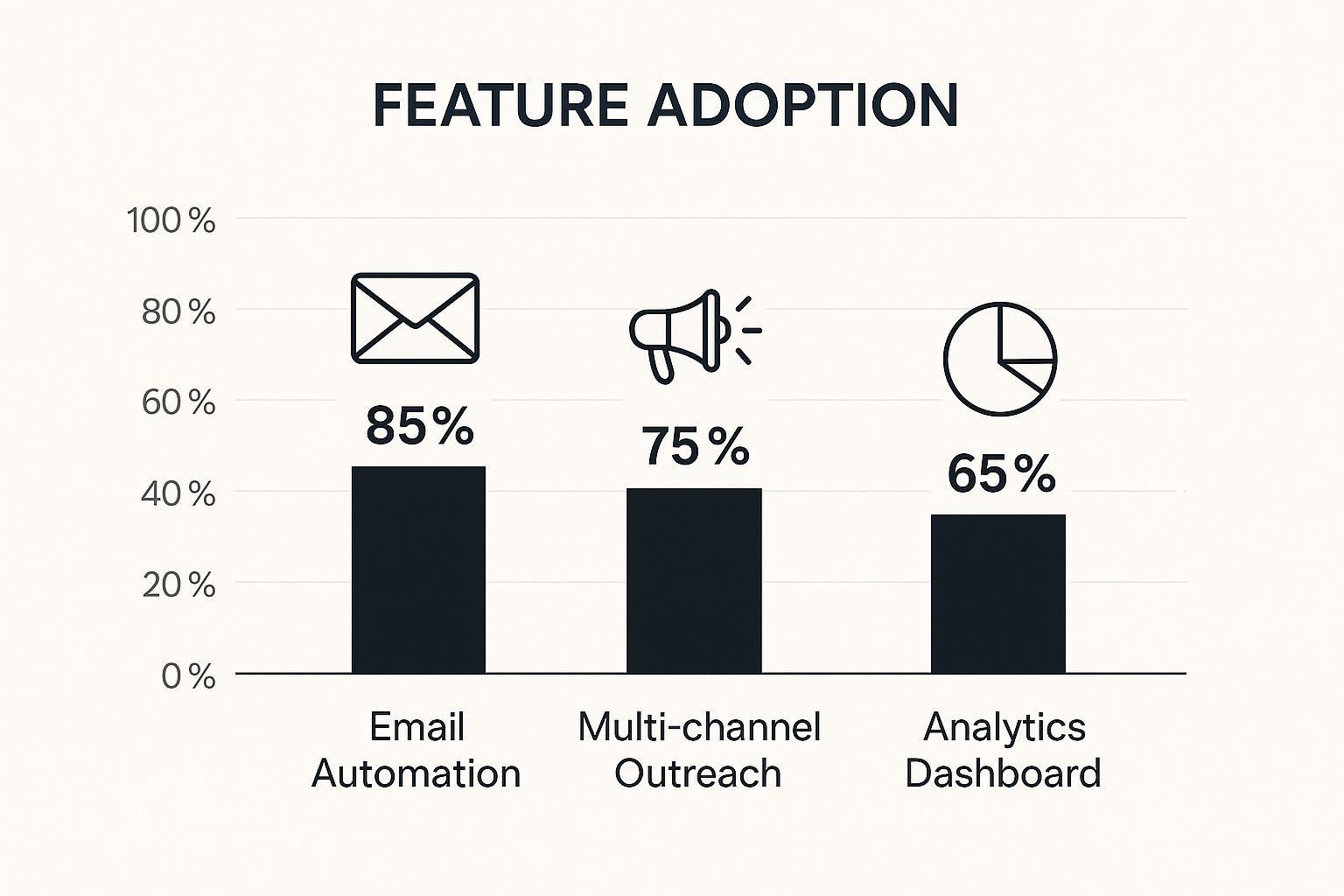Ever heard of a sales engagement platform (SEP)? In simple terms, it's a piece of software that brings some much-needed order to the chaos of a modern sales team. It automates and organizes the way your reps connect with potential customers across every channel.
Think of it as an intelligent command center for your sales force. It takes all the raw data from your CRM—every email, call, and social media touchpoint—and turns it into a structured, measurable game plan. This ensures no lead ever falls through the cracks again.
Unpacking the Role of a Sales Engagement Platform

Here's an analogy I like: Imagine an orchestra conductor. Each musician has their instrument and sheet music (that's your customer data sitting in a CRM). But it's the conductor who ensures they all play in perfect harmony, creating a masterpiece. A sales engagement platform is that conductor for your sales team, orchestrating every single interaction.
This is a huge step up from your standard CRM. A CRM is a fantastic database, a system of record. But an SEP is a system of action. It plugs into your CRM, grabs the data, and uses it to build and run strategic outreach campaigns.
Why This Matters Now
Let's be real—the B2B buying journey has gotten complicated. You're not selling to one person anymore; you're navigating a whole committee of decision-makers, each requiring multiple touchpoints across different platforms. Relying on spreadsheets and manual reminders just doesn't cut it. It's a recipe for missed opportunities.
A sales engagement platform brings structure to this entire process. It automates the grunt work and tells reps exactly what to do next, which leads to some serious wins:
- Boosted Productivity: By automating follow-ups and admin tasks, reps get to spend more time doing what they're paid for—actually selling.
- Consistent Outreach: It guarantees every prospect gets the right message at the right time. No more leads going cold because someone forgot to follow up.
- Smarter Decisions: You get crystal-clear analytics on which messages and channels actually work, so you can stop guessing and start optimizing.
- Effortless Scaling: Sales teams can handle a much larger pipeline without needing to double their headcount just to keep up.
A sales engagement platform flips the script on sales. It transforms a reactive, manual grind into a proactive, automated, and incredibly efficient operation. It gives reps the power to build stronger relationships at scale by making sure every interaction is purposeful and perfectly timed.
The market is exploding for a reason. Valued at $7.87 billion in 2023, the global SEP market is on track to hit a staggering $29.62 billion by 2033. This isn't just a trend; it's a fundamental shift. As businesses grapple with increasingly complex buyer journeys, SEPs have become an essential part of the modern sales toolkit.
You can explore more about this market forecast on superagi.com. In today's competitive landscape, the ability to automate and analyze outreach isn't a luxury—it's a requirement for success.
Core Features of a Modern Sales Engagement Platform
To really get what makes a sales engagement platform tick, you have to look under the hood. It’s not just a random collection of tools thrown together; it’s a fully integrated system where every feature makes the others more powerful. These platforms are designed from the ground up to solve the biggest headaches in modern sales.
At the very heart of any good SEP is multi-channel sequence automation. Think of it as a smart, automated playbook for your outreach. Instead of a rep manually tracking when to email, call, or connect on LinkedIn, they simply enroll a prospect into a pre-built sequence. The platform then takes over, executing all those touchpoints over days or weeks, making sure no one ever falls through the cracks.
A huge part of this is, of course, email. But we're talking about more than just sending messages. To really get results, it's wise to lean on proven email automation best practices. This is how you make sure your automated emails don't just get sent, but actually get opened, read, and acted upon.
Unlocking Performance With Data And AI
While automation handles the "what" and "when," the real game-changer is the analytics that answers "why." A modern SEP gives you incredibly deep insights into how your campaigns are actually performing. Reps and managers can see, clear as day, which email templates, call scripts, or sequence steps are getting replies and booking meetings.
This data-first approach takes all the guesswork out of selling. For instance, you can A/B test two different email subject lines and see in real time which one is winning. This constant feedback loop lets your team fine-tune their approach based on what the market is actually telling them.
AI-driven insights are the next level of intelligence. A truly powerful SEP doesn't just show you what happened in the past; it guides your next move. It can suggest the best time of day to contact a prospect, recommend the most effective channel, and even score leads based on how engaged they are.
This infographic breaks down how widely different SEP features have been adopted.

As you can see, while almost everyone is doing basic email automation, the real power—and what separates the top performers—comes from using multi-channel outreach and deep analytics.
The Critical Role Of CRM Integration
Finally, none of these amazing features would mean much without deep CRM integration. Let's be clear: an SEP isn't here to replace your CRM. It's here to supercharge it. Every single activity that happens in the sales engagement platform—every email sent, call logged, and task checked off—is automatically synced back to the right contact record in your CRM.
This creates a single source of truth for your entire team and kills the soul-crushing, error-prone task of manual data entry. It means your CRM data is always pristine and up-to-date, giving you a complete, 360-degree view of every customer interaction.
To really drive home the unique value an SEP brings to the table, it helps to see it compared side-by-side with the tools you're probably already using.
Sales Engagement Platform vs Traditional Sales Tools
| Functionality | CRM (e.g., Salesforce) | Email Automation (e.g., Mailchimp) | Sales Engagement Platform |
|---|---|---|---|
| Primary Role | Stores customer data (System of Record) | Sends bulk email campaigns | Orchestrates sales outreach (System of Action) |
| Outreach | Manual or basic task reminders | One-way email blasts | Automated multi-channel sequences (email, call, social) |
| Analytics | Reports on deals and contacts | Focuses on open/click rates | Tracks rep activity, sequence performance, and engagement |
| AI Insights | Limited or non-existent | Basic segmentation | Suggests next best actions and optimal contact times |
This table makes it clear how a sales engagement platform fills a massive gap in the typical sales stack. It turns the passive data sitting in your CRM into proactive, intelligent, and coordinated action.
How SEPs Transform Daily Sales Workflows

To really get what a sales engagement platform (SEP) can do, you have to see what a sales rep's day looks like with and without one. First, picture the daily grind without it: a chaotic world of scattered spreadsheets, manually logging every single call, and a desk covered in sticky notes for follow-up reminders. It's a purely reactive process where good, high-value leads can easily fall through the cracks and be forgotten.
Now, let's flip the script. With an SEP, that same rep's day is proactive and structured. Instead of sitting there wondering who to call next, the platform tells them exactly what to do. Every lead gets enrolled in a pre-built sequence of emails, calls, and social touches, making sure no opportunity ever goes cold. This automated choreography is the real difference between disorganized effort and systematic success.
From Manual Chaos to Automated Precision
Before an SEP, a sales rep could easily burn hours every week just on admin tasks. In fact, research shows this kind of manual work can eat up as much as 25% of a sales professional's time. This isn't selling; it's logging calls in the CRM, setting calendar reminders for follow-ups, and copy-pasting the same email templates over and over. It’s slow, wildly inefficient, and a breeding ground for human error.
An SEP automates almost all of it. A rep hangs up from a call, and the platform is already logging the outcome, scheduling the next touchpoint, and pushing the prospect to the next step in the sequence. This single change frees up a massive amount of time, letting reps focus on what they're actually paid to do: building relationships and closing deals. If you're curious about how automation helps in other business areas, looking at these various workflow automation examples can give you a broader perspective.
A sales engagement platform doesn't just make reps faster; it makes them smarter. By automating the mundane, it elevates their role from task-doer to strategic advisor, empowering them to have more meaningful conversations.
Concrete Use Cases in Action
Let’s look at two common scenarios where an SEP is a complete game-changer.
- Outbound Prospecting: Imagine a rep is targeting a new list of accounts. They can launch a multi-channel sequence that methodically warms up cold leads over several weeks. An automated email might go out on day one, a LinkedIn connection request on day three, and a call task gets created for day five. The rep isn't guessing; they're just following a proven playbook, confident that every prospect is getting consistent, timely outreach.
- Inbound Lead Nurturing: A new lead comes in by downloading an ebook from your website. They are instantly and automatically added to a nurturing sequence. They get a thank-you email right away, followed by related blog posts or case studies over the next few days. If they click a link in one of those emails, the SEP can send an immediate alert to the rep, flagging them as a high-intent lead who is ready for a personal phone call.
These kinds of structured workflows have a direct impact on the bottom line. For sales managers, it means they can finally get accurate forecasts based on real-time activity data, not just a rep’s gut feeling. For the whole company, it builds a much more predictable revenue engine. This structured approach is a cornerstone of modern B2B sales lead generation, and it's essential for scaling growth.
It’s a Small World After All: The Global Rise of Sales Engagement Tech
The need for sales engagement platforms isn't just a local trend—it's a full-blown global phenomenon. Why? Because the very DNA of how businesses buy and sell has changed. The pivot to virtual and remote selling, which ramped up massively a few years back, is here to stay. This has kicked up an urgent demand for tools that can wrangle complex, digital-first sales conversations across countless time zones and cultures.
This isn't just a flash in the pan. The entire B2B sales model has been turned on its head. Sales teams that once shared a coffee machine in a single office are now scattered across the globe. Meanwhile, buyers expect a smooth, personalized digital experience no matter where they are. A solid sales engagement platform acts as the central nervous system for this new reality, creating a single source of truth for teams spread across continents.
Who's Adopting and How Fast?
The pace at which sales engagement tech is being adopted varies wildly from place to place, really painting a picture of different tech comfort levels and business priorities around the world.
The market's growth reflects these massive shifts in technology and how we work. While the global market was pegged at $7.87 billion in 2023, its future is anyone's guess. Some analysts are betting on a climb to $11.1 billion by 2033, but others are pointing to a much more explosive figure, potentially hitting $29.62 billion in that same period. That huge range tells you two things: the market is a bit unpredictable, but the growth potential is absolutely immense. You can dive deeper into these sales engagement platform trends on superagi.com.
This growth isn't spread evenly, though. We're seeing some clear regional stories unfold:
- North America: These guys are leading the charge. With a mature SaaS market and a culture that jumped on digital sales tools early, SEPs have become a standard piece of the tech stack here.
- Europe: Hot on North America's heels and catching up fast, largely thanks to a big push for digital transformation across the board. The big hurdle here? Data privacy. Platforms with rock-solid GDPR compliance are a must-have.
- Asia-Pacific (APAC): This is the one to watch. As more APAC companies go global, the demand for scalable, localized outreach tools is skyrocketing.
The bottom line is this: North America might be the most mature market right now, but the real fireworks are expected from Europe and APAC as their digital economies continue to boom.
Evolving for a Worldwide Audience
To keep up with sales teams that span the globe, the top sales engagement platforms are getting smarter. They're ditching the one-size-fits-all approach and baking in features built for international players. This means things like robust multi-language support, so reps can actually talk to prospects in their native language.
And it’s not just about language. Staying on the right side of international data privacy laws is no longer a "nice-to-have"—it's table stakes. The best platforms have compliance built right in, helping businesses navigate complex rules like GDPR in Europe and other regional data laws. This allows companies to scale their sales efforts across borders without constantly looking over their shoulder.
Honestly, this focus on localization and compliance is what separates a decent SEP from a great one in today's connected world.
Choosing the Right Sales Engagement Platform

Picking a sales engagement platform feels a lot like buying a new car. You wouldn't show up at the dealership and just grab the shiniest one. You'd think about your life—do you need a truck for hauling gear or a compact for tight city parking?
It's the exact same with software. The "best" platform isn't the one with a million features; it's the one that actually solves your team's biggest headaches.
So, before you even think about booking a demo, the first step is to look inward. Get your sales team in a room (or on a call) and get brutally honest about what's broken.
Are leads slipping through the cracks because follow-up is all over the place? Are your reps drowning in manual data entry instead of selling? Or maybe you're just guessing which email templates and call scripts are actually working. Nail down that one core problem. That’s your guiding light for this whole process.
Key Evaluation Criteria
Once you know the problem you’re solving, you can start looking at tools with a clear purpose. As you explore different platforms, these are the make-or-break areas to grill them on.
- CRM Integration Quality: This is a total deal-breaker. You need to ask how deep the integration really goes. Does it offer a true, two-way sync with your CRM? Every email, call, and task has to log automatically. If your reps have to do any manual data entry, the tool has failed.
- Ease of Use: A platform packed with features is completely worthless if your team hates using it. Seriously, get your reps involved in the demos. A good SEP should feel like it was built for them, making their day-to-day work smoother, not adding another complicated system to learn.
- Scalability for Growth: Think ahead. Where will your team be in 18-24 months? Make sure the platform can grow with you. Look at their pricing tiers, how easy it is to add new users, and whether it has the muscle to support a larger, more complex sales team down the road.
Think of it this way: The platform should be a partner in your growth, not a roadblock. It needs to handle your current volume while having the capacity to support your future ambitions without requiring a complete overhaul.
Making a Confident Decision
With your list of pain points and these criteria in hand, you can walk into demos with a real agenda. Don't get distracted by a slick sales pitch.
Ask pointed questions that tie directly back to the problems you identified. If productivity is your main issue, say, "Show me exactly how your platform automates the admin tasks that are bogging my team down."
By keeping your reps in the loop and staying laser-focused on solving your core challenges, you can pick a platform that actually delivers a return on your investment. The goal isn't just to buy a tool; it's to find something that makes your team’s life easier so they can focus on what they do best—selling.
For a deeper look into what to look for, our complete guide to sales engagement platforms offers even more detailed insights to help you make the right choice.
Answering Your Top Questions About SEPs
Diving into a new piece of tech like a sales engagement platform always brings up questions. It's a big deal—it changes how your sales team fundamentally works day-to-day. So, getting clear on the details isn't just nice, it's necessary.
Let's cut through the jargon and get straight to the real-world questions I hear all the time. My goal is to help you build a rock-solid case for using an SEP and feel confident about what you’re getting into.
What Is the Main Difference Between a CRM and an SEP?
This is easily the most common question, and getting this right is everything.
Think of your CRM as the team's digital filing cabinet. It’s a system of record, a database where you stash all that precious customer info: contact details, company history, past deals. It’s essential, but it’s also passive. It just sits there holding data.
An SEP, on the other hand, is a system of action. It hooks directly into that filing cabinet, pulls out the relevant information, and puts it to work. The SEP is what actually does the outreach—automating the sequence of emails, scheduling the calls, and lining up social media touches.
Bottom line: Your CRM holds the playbook. Your SEP runs the plays.
How Long Does It Take to Implement a Sales Engagement Platform?
I get it. The thought of rolling out another piece of software can feel exhausting. But here's the good news: modern SEPs are built to get you up and running fast. While it depends on your team's size, you can realistically expect to be fully operational within a few weeks, not months.
The process usually breaks down into a few straightforward stages:
- Connecting to Your CRM: The first move is getting the SEP talking to your CRM, creating a seamless, two-way data sync.
- Setting Up Users: Next, you'll get each of your reps set up with their own account.
- Building Initial Sequences: This is the fun part. You'll create your first few outreach cadences, and most platforms have great templates to get you started.
- Training the Team: Finally, you'll walk your reps through how to weave the platform into their daily routine.
The best platforms don't just throw you the keys and wish you luck. They offer guided onboarding and have support teams ready to help you nail each step.
Can a Small Sales Team Benefit from an SEP?
Absolutely. In fact, I'd argue small teams need an SEP more than anyone. For a small crew, an SEP isn't just a tool; it's a force multiplier.
When you only have a handful of reps, you can't afford to have them bogged down in busywork. An SEP automates the repetitive admin tasks that can eat up to 25% of a rep's day. For a small team, getting that time back is a game-changer.
It allows a few reps to do the work of many, engaging a huge pool of prospects without losing that personal touch. More importantly, it ensures no lead ever falls through the cracks, which is mission-critical when every single opportunity makes or breaks your month.
How Do You Measure the ROI of a Sales Engagement Platform?
Measuring the return on an SEP is refreshingly direct because you can tie its impact to the sales metrics that actually matter. The trick is to take a "before" snapshot of your key numbers, then track the "after" once the platform is live.
The most effective way to prove ROI is by tracking key performance indicators before and after adoption. Look for clear, quantifiable improvements in activities that directly influence revenue.
Here’s what you should be laser-focused on:
- Rep Productivity: Are your reps making more calls, sending more emails, and booking more meetings each day?
- Meeting Booking Rates: What percentage of prospects are actually agreeing to a meeting? This should go up.
- Conversion Rates: Are more of your leads turning into qualified opportunities? For more on this, check out these strategies to improve your sales conversion rate.
- Sales Cycle Length: Is the average time it takes to close a deal—from first touch to signed contract—getting shorter?
Ready to see how a sales engagement platform can transform your outreach? Salesloop.io gives you the power to automate multichannel campaigns, generate high-quality leads, and scale your sales efforts with ease. Discover how Salesloop.io can accelerate your pipeline growth today.





